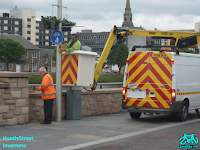[Any of the images can be clicked to enlarge.]

A Toucan Crossing has been installed at the far end of Ness Bridge in Inverness. It links and aligns with Huntly Street and Ness Walk to provide pedestrians with a straight route along the riverside. The junction has been painted with a yellow box. There are dropped kerbs all around the junction apart from, puzzlingly, one kerb on Young Street.
The main traffic is in four lanes between the Ness Bridge (city centre side) and Young Street (leading to the main road to Fort William). The side roads (Ness Walk and Huntly Street) are both one-way (away from the camera). When this (first) phase has a green light any traffic from Huntly Street is stopped but there may be some traffic turning into Ness Walk from either direction. So this is a safe time to cross Huntly Street although there is no signal for pedestrians.
On the second phase, the main traffic is stopped allowing traffic from Huntly Street to cross to Ness Walk or turn right into Young Street. Turning left from Huntly Street onto Ness Bridge is explicitly prohibited. This was done on purpose to deter rat-running along Huntly Street into the city centre.Also in this phase, pedestrians can cross all 4 lanes of the Toucan Crossing.

When the Green Man appears on the Toucan Crossing the audible signal can be heard by any pedestrian heading towards Young Street. This can give the false impression that it is safe to cross Huntly Street (and possibly Ness Walk) when actually traffic from Huntly Street has been given a Green Light.

Pedestrians (particularly visitors) using the Toucan Crossing may wrongly assume that a Green Man means that ALL traffic has been stopped and that it is safe to cross diagonally by the yellow box. As a result they may unwittingly put themselves in front of cars from Huntly Street.
Even if they keep within the crossing they might need to watch for traffic illegally turning left onto Ness Bridge.
 Up to this point I haven't mentioned cyclists although it is a Toucan Crossing. As is often the case the Highland Council have left it for cyclists to determine their own routes and negotiate with other road users. Many cyclists will stay on the road. I understood that the original intention was to provide a small lane to allow cyclists to turn left from Huntly Street. There is no signage to indicate this. In practice, I suppose this could be the route I've indicated across the blister paving but that would be so wrong.
Up to this point I haven't mentioned cyclists although it is a Toucan Crossing. As is often the case the Highland Council have left it for cyclists to determine their own routes and negotiate with other road users. Many cyclists will stay on the road. I understood that the original intention was to provide a small lane to allow cyclists to turn left from Huntly Street. There is no signage to indicate this. In practice, I suppose this could be the route I've indicated across the blister paving but that would be so wrong. There is an exception that allows contra-flow cycling along the full length of Huntly Street. How this is intended to work at this junction remains a mystery. It is clearly legal to cycle across the Toucan Crossing except that the pavement at each end has not been designated for cycling (or shared use). Again, it might be legal to cycle across the corner - but not advisable. The Toucan Crossing will encourage (illegal) pavement cycling. This photo also shows that it's not uncommon for drivers to stop their vehicle on the crossing and/or the yellow box.
There is an exception that allows contra-flow cycling along the full length of Huntly Street. How this is intended to work at this junction remains a mystery. It is clearly legal to cycle across the Toucan Crossing except that the pavement at each end has not been designated for cycling (or shared use). Again, it might be legal to cycle across the corner - but not advisable. The Toucan Crossing will encourage (illegal) pavement cycling. This photo also shows that it's not uncommon for drivers to stop their vehicle on the crossing and/or the yellow box.Summary
The goal of reducing rat-running along Huntly Street seems to be a success. However this depends on drivers being responsible and the law being enforced on drivers who don't comply.
Drivers on Young Street need to take care that there will be enough space beyond the Toucan Crossing so that their vehicle will not end up blocking the crossing and/or the yellow box.
Pedestrians can cross Young Street with the help of a central refuge. It's odd that there is a dropped kerb on one pavement but not the opposite one. There are no pedestrian signals here.
Crossing Ness Walk, particularly from Ness Bridge, can be difficult. There is always the potential for traffic to enter Ness Walk from any of three different direction at different times.
There is a safe phase to cross Huntly Street but there is potential for confusion.
The inclusion of a phase that allows pedestrians and cyclists to cross the junction in all directions, including diagonally, might be safer. Or expressing it in a different way, extend the Toucan phase to the whole juction and give Huntly Street a phase of its own.
Your comments are welcome.












































